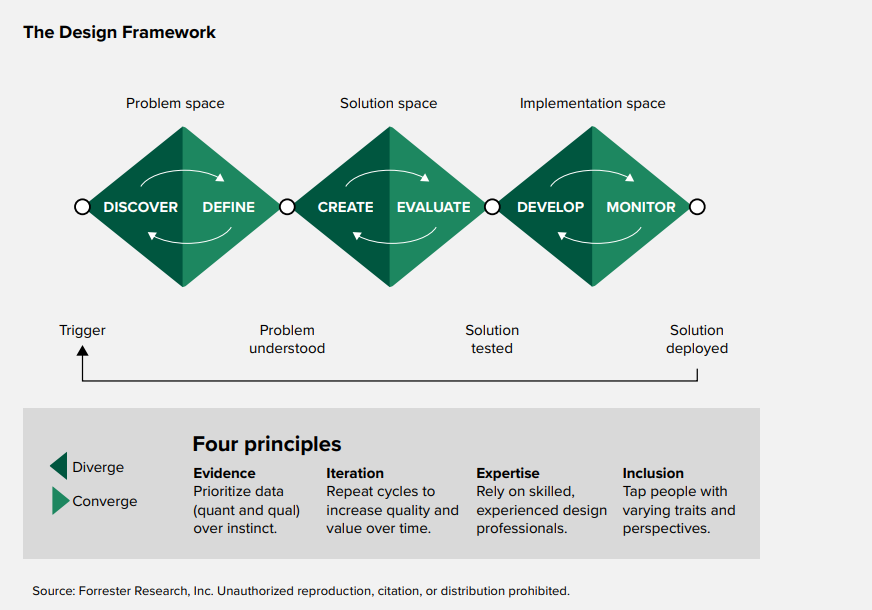After considering your responses to these two inquiries, determine which of the following scenarios aligns most closely with your current situation. This will guide your selection of design techniques, ensuring you use the most appropriate tools for the task at hand.
Before delving further into this process, let’s briefly explore the design framework—a commonly utilized concept showcasing an efficient design approach. Take a look at the three spaces and four principles of effective design:

Consider the design framework to determine which chatbot scenario aligns closest with your organization’s current situation:
- Chatbot Doesn’t Exist Yet, Undefined Scope: This scenario, ideal for design professionals, corresponds to the problem space. Design experts should lead iterative cycles of discovery and definition to understand users’ needs accurately and identify the chatbot’s optimal functionalities.
- Chatbot Not Launched, Well-Defined Scope: Commonly encountered, this scenario maps to the solution space. Organizations often aim to divert inquiries from human representatives, creating a prototype based on simplified requests. While not ideal, it allows for iteration between the creation and evaluation stages, though additional discovery work may uncover further user needs.
- Existing Chatbot, Undefined Scope: Time for a reset. When scope lacks clarity, bots may struggle due to broad intent recognition. It’s advisable to restart with a refined scope to enhance performance and effectiveness.
- Launched Chatbot, Well-Defined Scope: Following deployment, ongoing adaptation is crucial. Iterating between development and monitoring, organizations must continually refine the bot’s performance based on evolving user needs and technological advancements.
Remember, effective chatbot design involves continual refinement and adaptation to ensure optimal user engagement and satisfaction.
Design Real Conversational Experiences
Regardless of your chatbot progress, your organization stands to gain by:
• Incorporating design expertise: If designers aren’t yet part of your chatbot initiatives, prioritize their inclusion. If you lack the authority to do so independently, leverage this guide’s insights to advocate for their involvement.
• Developing conversation design proficiency: Amidst high demand for conversation designers, consider hiring or upskilling to cultivate this capability. Ensure all team members grasp chatbot design fundamentals, fostering a core group with specialized expertise.
• Simplifying initial efforts: When starting out, opt for a straightforward approach without AI complexity. Begin with well-designed decision trees before integrating machine learning capabilities gradually. A basic approach, as recommended by experts, can resolve the majority of issues effectively.
By prioritizing customer needs, setting realistic expectations, and embracing iterative refinement, your organization can leverage chatbots effectively, gaining a competitive edge in customer engagement and business outcomes.







